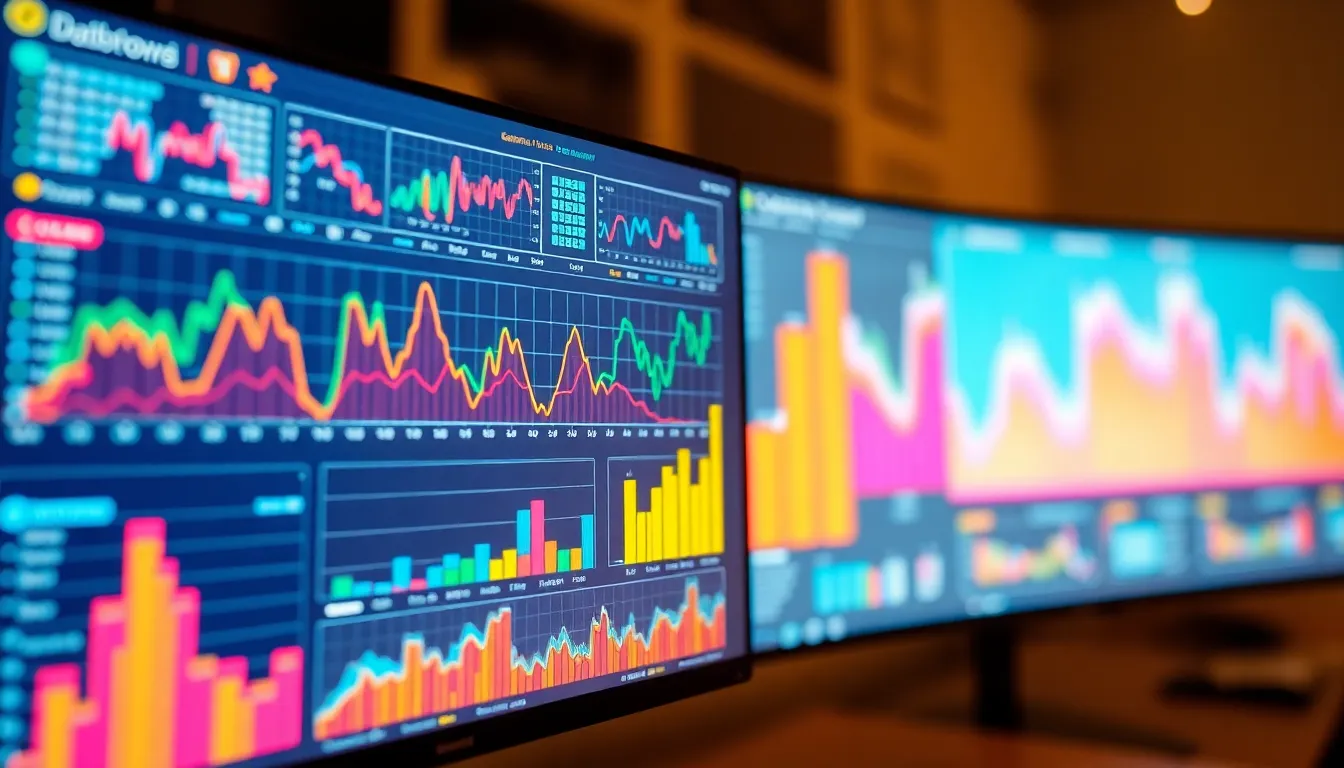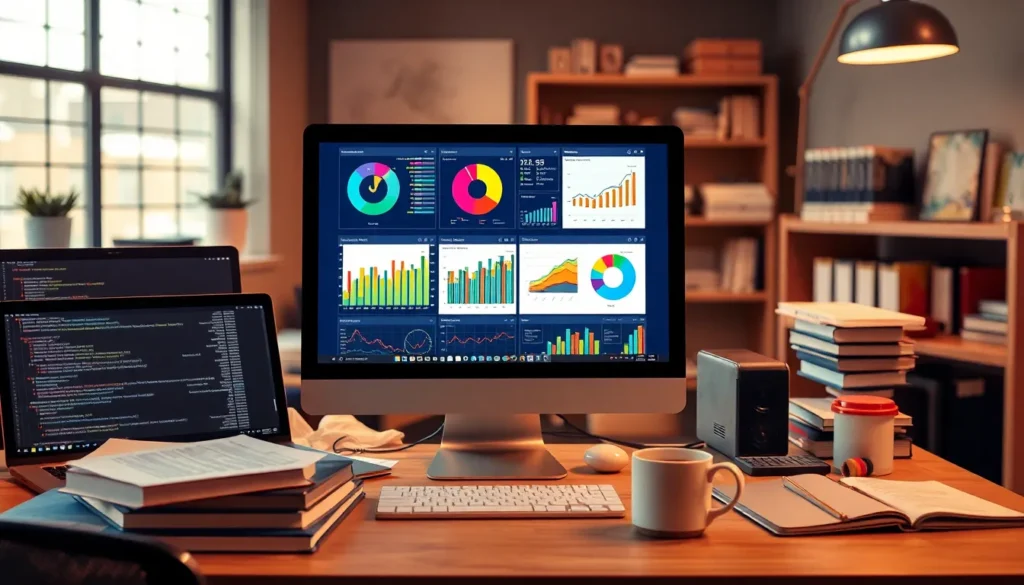Table of Contents
ToggleIn a world overflowing with data, turning numbers into captivating visuals can feel like trying to find a needle in a haystack. Enter D3.js, the superhero of data visualization that transforms mundane datasets into eye-popping graphics. With its powerful capabilities, D3.js lets developers create interactive charts and graphics that not only inform but also entertain. Who knew data could look this good?
Overview of D3.js
D3.js stands for Data-Driven Documents. This JavaScript library enables developers to manipulate documents based on data. Using D3, he or she can bind data to a Document Object Model (DOM) and apply data-driven transformations to the document. Visualizations created with D3.js are highly customizable and can respond dynamically to user input.
Data visualization elements include charts, graphs, and interactive maps. Developers can create a variety of visual representations, such as bar charts, pie charts, and scatter plots. Each visualization can be designed to animate on data change, enhancing user interaction and engagement.
D3.js supports a selection of web standards, including HTML, SVG, and CSS. This allows for seamless integration into web pages. Responsive designs can easily adapt to various screen sizes, ensuring accessibility on multiple devices.
Interactivity features play a crucial role in D3.js, offering developers tools for user engagement. Events like mouse hover or clicks can trigger updates or transitions in the visualizations, enriching user experience. D3’s powerful data binding capabilities utilize Enter, Update, and Exit selections to efficiently handle data changes.
Community support enhances D3.js functionality. A wide array of plugins and extensions exist to further empower developers. Resources such as documentation, tutorials, and forums provide guidance for both beginners and experienced users.
Overall, D3.js proves fundamental for developers aiming to create professional-grade visualizations, pushing the boundaries of data presentation. Its flexibility and richness in features make it an essential tool in the field of data visualization.
Features of D3.js

D3.js offers a robust suite of features that empower developers to create highly interactive and customized data visualizations.
Data Binding
Data binding serves as a foundational feature of D3.js. This functionality allows developers to connect data directly to the DOM elements. By leveraging the Enter, Update, and Exit selections, D3.js efficiently manages changes in data. When new data arrives, it updates existing visualizations seamlessly. Each data point can relate directly to a specific visual element, ensuring clarity in presentation. Through this dynamic binding, developers can ensure that their visual outputs are always reflective of the underlying datasets.
Dynamic Properties
Dynamic properties enhance the interactivity of D3.js visualizations. Developers can change properties based on data values, creating responsive elements that react to user inputs. For instance, colors or sizes of visual elements can adjust according to specific thresholds or user interactions. This capability enables the creation of engaging user experiences, as viewers can interact with the data in real-time. By using transitions and animations, these changes become visually appealing, capturing attention while conveying crucial information.
Advantages of Using D3.js
D3.js provides numerous advantages that empower developers to create exceptional data visualizations. Its features enhance functionality, making it an invaluable tool.
Flexibility and Customization
Flexibility stands out as a crucial advantage of D3.js. Developers can design visualizations tailored to specific needs, from simple bar charts to intricate data-driven graphics. Customization options allow manipulation of every element and parameter, ensuring unique results. This adaptability supports various data formats, making it easy to integrate diverse datasets into a cohesive visual narrative. Transition effects and animations can be integrated seamlessly, enhancing interactivity and engagement. Every aspect of a project can reflect the distinct style of the developer, catering to unique audience preferences.
Large Community Support
Community support plays a vital role in the effectiveness of D3.js. A vibrant ecosystem of developers shares knowledge through forums, documentation, and tutorials. Access to a wide range of plugins enriches functionality, allowing for enhanced visualization capabilities. Continuous contributions lead to regular updates, ensuring the library remains relevant and powerful. This active community helps beginners and experienced users alike, providing solutions to common challenges. Collaborative efforts foster innovation, driving the development of new techniques and visualization methods. Developers can benefit from shared resources, accelerating their learning curve while maximizing project impact.
Common Use Cases for D3.js
D3.js excels in a variety of data visualization applications. Its versatility makes it a popular choice among developers.
Data Visualization
Data visualization stands as a core use case for D3.js. The library transforms complex datasets into engaging visual formats. Developers can create line graphs, bar charts, scatter plots, and more, all tailored to specific needs. D3.js supports diverse data formats, enabling seamless integration of JSON, CSV, and APIs. Additionally, the library’s powerful data binding capabilities simplify updates to visual representations. Users benefit from dynamic visualizations that change as underlying datasets evolve. Flexible customization options provide control over colors, scales, and styles. These attributes combine to ensure that information is conveyed effectively and attractively.
Interactive Graphs
Interactive graphs represent a key advantage of D3.js. The library enables users to engage directly with visualizations through actions like clicking and hovering. These interactions facilitate real-time data exploration, allowing users to gain insights on demand. Developers utilize features such as transitions, which animate changes smoothly, enhancing user experience. Programmers can implement tooltips that display additional details upon interaction, increasing comprehension. Furthermore, D3.js allows for interactive filters that let users manipulate displayed data effortlessly. Such capabilities promote deeper understanding and encourage analytical thinking. Overall, the library’s focus on interactivity elevates data visualization beyond static representations.
Getting Started with D3.js
Getting started with D3.js involves setting up the necessary environment and exploring basic visualization examples.
Setting Up the Environment
Begin by ensuring the latest version of D3.js is included in your project. Developers can download the library from the official D3.js website or use a package manager like npm or yarn. Installing through npm requires the command npm install d3. Create an HTML file and link the D3.js script within the <head> section to make D3 functionalities available. Incorporating additional styles with CSS enhances visual appeal, while a simple server setup facilitates local testing of visualizations. Properly structuring files within your project will streamline development and make collaboration easier.
Basic Example
Starting with a basic example illustrates the core capabilities of D3.js. Developers can create a simple bar chart to showcase data. For this, they need a dataset array, which includes numerical values. Binding this data to SVG elements enables developers to generate rectangles that represent each data point. Specify attributes like width, height, and fill color for visual differentiation. Add axes to provide context for viewers, enhancing clarity. Using transitions animates the visual changes, making the interaction more engaging. Exploring various data formats supports the flexibility needed for diverse projects, leading to richer visual narratives.
D3.js stands as a transformative force in the realm of data visualization. Its ability to create interactive and dynamic graphics empowers developers to tell compelling stories through data. By leveraging its robust features like data binding and customizable elements, users can craft visualizations that not only inform but also engage audiences.
The strong community backing D3.js further enhances its appeal, providing resources and support that facilitate learning and innovation. As developers continue to explore its capabilities, D3.js will undoubtedly remain a go-to library for those looking to elevate their data visualization projects. Embracing D3.js opens the door to endless possibilities in presenting data in visually striking ways.




